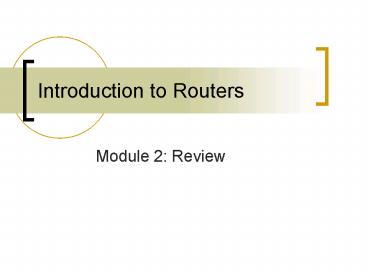Introduction to Routers - PowerPoint PPT Presentation
1 / 20
Title:
Introduction to Routers
Description:
One way is through a console session. A console uses a low speed serial connection ... Where the image runs and whether it has been zipped or compressed ... – PowerPoint PPT presentation
Number of Views:46
Avg rating:3.0/5.0
Title: Introduction to Routers
1
Introduction to Routers
- Module 2 Review
2
2.1.2 Router user interface
- Another method of accessing a CLI session is to
Telnet to the router. - To establish a Telnet session to the router
network functionality is required.
3
2.1.2 Router user interface
- Access the CLI
- One way is through a console session. A console
uses a low speed serial connection directly from
a computer or terminal to the console connection
on the router. - Another way to access a CLI session is by use of
a dialup connection using a modem or null modem
connected to the router AUX port.
4
2.1.3 Router user interface modes
- As a security feature the Cisco IOS software
separates the EXEC sessions into two access
levels. - User EXEC mode
- Privileged EXEC mode.
- Global configuration mode can only be reached
from the privileged EXEC mode. - The privileged EXEC mode can be identified by the
"" prompt. - Ex.
- Router gt enable
- Routerconfig t
5
2.1.3 Router user interface modes
- The following are the features of the user EXEC
mode and privileged EXEC mode - The user EXEC mode allows only a limited number
of basic monitoring commands. - The privileged EXEC mode provides access to all
router commands. This mode can be configured to
require a password. For added protection, it can
also be configured to require a user ID. The
privileged EXEC mode can be identified by the
prompt.
6
2.1.4 Cisco IOS software features
- Specific IOS features can be selected using the
Cisco Software Advisor. - Use the show version command on the Cisco device
to check the current image and available flash - To find out the amount of flash memory, and all
of the IOS image files on the router issue the
show flash command
7
2.1.4 Cisco IOS software features
- The naming convention for the different Cisco IOS
releases contains three parts - The platform on which the image runs
- The special features supported in the image
- Where the image runs and whether it has been
zipped or compressed
8
2.1.5 Operation of Cisco IOS Software
- The ROM monitor performs the bootstrap process
and provides low-level functionality and
diagnostics - Change registry settings
- Replace Cisco IOS image files
9
2.2.1 Initial startup of Cisco routers
- The goal of the startup routines for Cisco IOS
software is to start the router operations. To do
this, the startup routines must accomplish the
following - Make sure that the router hardware is tested and
functional. - Load bootstrap
- Find and load the Cisco IOS software.
- Find and apply the startup configuration file or
enter the setup mode.
10
2.2.1 Initial startup of Cisco routers
- The router will enter setup mode under the
following conditions - After issuing the command Routersetup
- During the initial configuration of the router
- After deleting the backup configuration and
reloading the router
11
2.2.1 Initial startup of Cisco routers
- The default sequence for loading the IOS
- FLASH
- TFTP
- ROM
12
2.2.1 Initial startup of Cisco routers
- The default sequence for loading the
configuration file - NVRAM
- TFTP
- CONSOLE
13
2.2.2 Router LED indicators
- The green OK LED to the right of the AUX port
will be on after the system initializes
correctly.
14
2.2.4 Establishing a HyperTerminal session
- Take the following steps to connect a terminal to
the console port on the router - Connect the terminal using the RJ-45 to RJ-45
rollover cable and an RJ-45 to DB-9 or RJ-45 to
DB-25 adapter. - Configure the terminal or PC terminal emulation
software for 9600 baud, 8 data bits, no parity, 1
stop bit, and no flow control.
15
2.2.5 Logging into the router
- To return to the privileged EXEC mode from the
global configuration mode, type exit or Ctrl-Z.
Ctrl-Z may also be used to return directly to the
privileged EXEC mode from any sub-mode of global
configuration.
16
2.2.5 Logging into the router
- Two commands can be used to set a password used
to access privileged EXEC mode enable password
and enable secret. If both commands are used, the
enable secret command takes precedence.
17
2.2.6 Keyboard help in the router CLI
- When a --More-- prompt appears, press the
Spacebar to view the next available screen. To
display just the next line, press the Return or
Enter key.
18
2.2.7 Enhanced editing commands
- Ctrl-A will return a user directly to the
beginning of the line. - Routersh?
- Returns all commands beginning with the letters sh
19
2.2.8 Router command history
- The maximum number of commands allowed in the
history buffer is 256. - The command history feature can be used to
perform the following tasks - Set the command history buffer size
- Recall commands
- Disable the command history feature
20
2.2.10 The show version command
- The show version command displays information
about the Cisco IOS software version that is
currently running on the router. This includes
the configuration register and the boot field
settings. The show version command gives the
following information - IOS version and descriptive information
- Bootstrap ROM version
- Boot ROM version
- Router up time
- Last restart method
- System image file and location
- Router platform, interfaces
- Configuration register setting































